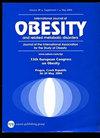比较异步远程交付与诊所交付生活方式干预的非劣效性随机试验。
IF 3.8
2区 医学
Q1 ENDOCRINOLOGY & METABOLISM
引用次数: 0
摘要
目的:生活方式干预是有效的,但通过面对面小组会议进行的干预在可扩展性和覆盖面方面都很差。需要研究确定远程提供的生活方式干预是否不逊于面对面提供的生活方式干预:我们进行了一项随机非劣效性试验(N = 329),将通过在线社交网络异步远程提供的生活方式干预(Get Social 条件)与通过面对面小组提供的生活方式干预(传统条件)进行比较。我们假设,"获取社交 "条件在 12 个月后的平均体重减轻百分比不低于传统条件。其他结果包括每减一磅的干预成本和可接受性(如便利性、支持、方式偏好):在 12 个月时,"社交 "疗法与传统疗法的体重变化百分比无明显差异(2.7% vs. 3.7%,p = 0.17),但不符合非劣效标准。"社交 "疗法每减一磅体重的成本为 21.45 美元,而传统疗法为 26.24 美元。更多的 "获取社交 "条件参与者认为参与活动很方便(65% 对 44%;P = 0.001):结果显示,远程提供的异步生活方式干预的减重效果略低于面对面干预,但可能更经济、更方便:ClinicalTrials.gov NCT02646618; https://clinicaltrials.gov/ct2/show/NCT02646618 .本文章由计算机程序翻译,如有差异,请以英文原文为准。


Randomized non-inferiority trial comparing an asynchronous remotely-delivered versus clinic-delivered lifestyle intervention
Lifestyle interventions are effective, but those delivered via in-person group meetings have poor scalability and reach. Research is needed to establish if remotely delivered lifestyle interventions are non-inferior to in-person delivered lifestyle interventions. We conducted a randomized non-inferiority trial (N = 329) to compare a lifestyle intervention delivered remotely and asynchronously via an online social network (Get Social condition) to one delivered via in-person groups (Traditional condition). We hypothesized that the Get Social condition would result in a mean percent weight loss at 12 months that was not inferior to the Traditional condition. Additional outcomes included intervention delivery costs per pound lost and acceptability (e.g., convenience, support, modality preferences). At 12 months, no significant difference in percent weight change was observed between the Get Social and Traditional conditions (2.7% vs. 3.7%, p = 0.17) however, criteria for non-inferiority were not met. The Get Social condition costs $21.45 per pound lost versus $26.24 for the Traditional condition. A greater percentage of Get Social condition participants rated participation as convenient (65% vs 44%; p = 0.001). Results revealed a remotely-delivered asynchronous lifestyle intervention resulted in slightly less weight loss than an in-person version but may be more economical and convenient. ClinicalTrials.gov NCT02646618; https://clinicaltrials.gov/ct2/show/NCT02646618 .
求助全文
通过发布文献求助,成功后即可免费获取论文全文。
去求助
来源期刊

International Journal of Obesity
医学-内分泌学与代谢
CiteScore
10.00
自引率
2.00%
发文量
221
审稿时长
3 months
期刊介绍:
The International Journal of Obesity is a multi-disciplinary forum for research describing basic, clinical and applied studies in biochemistry, physiology, genetics and nutrition, molecular, metabolic, psychological and epidemiological aspects of obesity and related disorders.
We publish a range of content types including original research articles, technical reports, reviews, correspondence and brief communications that elaborate on significant advances in the field and cover topical issues.
 求助内容:
求助内容: 应助结果提醒方式:
应助结果提醒方式:


